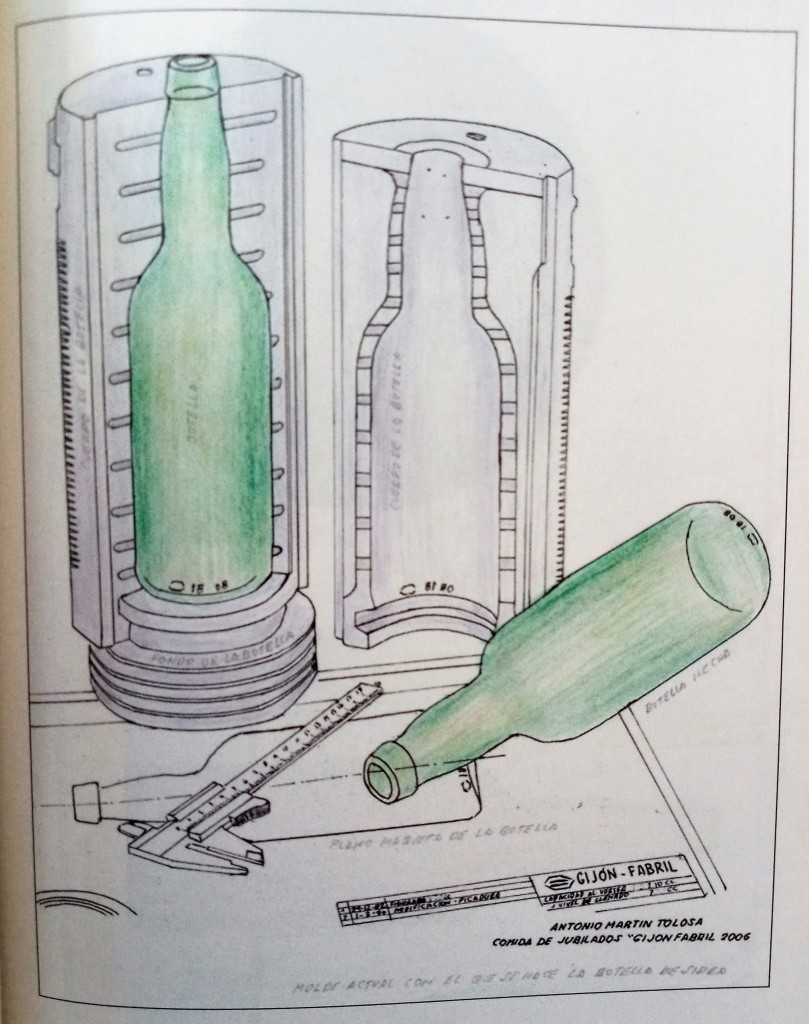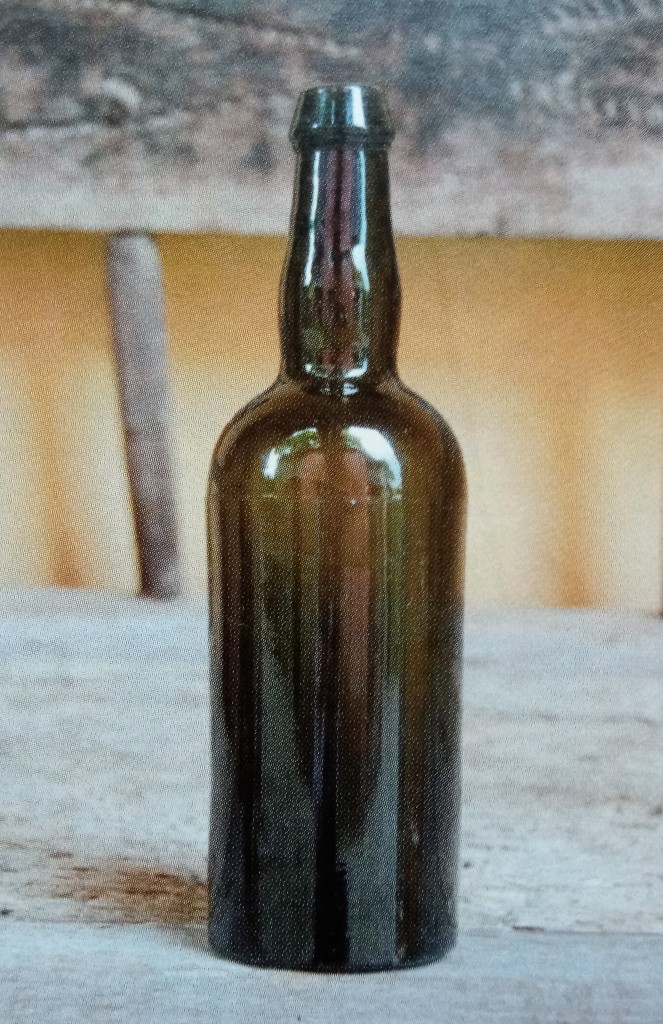We have been drinking cider for over 2,000 years, but when did the bottle of cider as we know it start to be used?
Ethnographer Inaciu Hevia Llavona, author of reference about cider and traditional cidermills and awarded in 2012 with the prize Fierro Botas for his essay “La Botella de Xixon. Orígenes y desendolcu hestóricu de la botella de sidra d’Asturies” («The bottle from Xixon, origins and historical development of the Asturian cider bottle»), explains the reasons for its design.
Before the cider bottle was invented, this was poured from the barrel into wooden jugs or “zapicas”. The current pouring imitates the way cider is poured from the barrel.
The “Bottle from Xixon”, as it is popularly known for having the name of the town engraved in its bottom, was made from 1844 in La Industria until the factory in La Calzada was opened, Gijon Industrial, later Gijon Fabril.
Llevamos tomando sidra más de dos mil años, pero ¿cuándo nació la botella de sidra tal y como la conocemos?
El etnógrafo Inaciu Hevia Llavona, autor de referencia sobre sidra y llagares tradicionales y galardonado en 2012 con el premio Fierro Botas por su ensayo “La Botella de Xixón. Orígenes y desendolcu hestóricu de la botella de sidra d’Asturies”, explica las razones de su diseño.
Antes de la invención de la botella de sidra, ésta se escanciaba desde el tonel en las jarras o zapicas. El escanciado actual es una imitación de cómo se espicha la sidra desde el tonel.
La “botella de Xixón”, como se conoce popularmente a la botella de sidra por llevar en su culo el nombre de la ciudad, se fabricaba desde 1844 en La Industria, hasta que se abre la fábrica de La Calzada, Gijón Industrial, posteriormente Gijón Fabril.



Gijon Fabril in the 50’s, La Industria workers, 1882. GF workers, 1956/ Gijón Fabril en los años 50. Trabajadores de La Industria, 1882. Trabajadores de GF, 1956.

Bottle corking/ Corchado de botellas 
Old bottles/ Botellas antiguas
The key date for the cider bottle birth is 1880, with the so-called “iron mould”, made with three-piece iron housing, whose shape has only changed by a few millimetres since then.
The first designs were inspired in the bottles made in England, following the Bordeaux model and they adapt to cider measurements, with a neck that allows the pouring through a characteristic curve, named “lady’s leg”, to diminish the cider exit speed.
The Truan brothers, in charge of the technical management in La Industria, used dark glass, sometimes black and even blueish, to protect the liquid from ultraviolet beams. At other times, they used oddities or manufacturing faults such as amber-coloured («colloraes») or transparent bottles, also known as «mexu de gatu» («cat’s pee»). Though the latter never convinced cidermakers or consumers. But in 1964, due to the bottle scarcity, the civil governor ordered to make them no matter how. Tens of thousands which nowadays are collectors’ gems.
Cider bottles are recycled in a high rate, so we could be drinking cider poured from an over 100 years old bottle!
La fecha clave para el nacimiento de la botella de sidra es 1880, con la denominada “molde fierro”, fabricada con moldes de tres piezas de hierro y cuya forma sólo ha variado unos milímetros desde esta fecha hasta la actual.
Los primeros diseños se inspiran en las botellas que se hacían en Inglaterra, siguiendo el modelo bordelés, y se adaptan a la medida de la sidra, con un cuello que permite el escanciado mediante la característica curva, denominada “pierna de dama”, para frenar la velocidad de salida de la sidra.
Los hermanos Truan, al frente de la dirección técnica de La Industria utilizaron vidrio oscuro, en ocasiones negro y hasta azulado, para proteger la bebida de los rayos ultravioleta. Otras veces se utilizaron rarezas o fallos de fábrica de color ámbar («les colloraes») o transparentes, las conocidas como «mexu de gatu». Aunque éstas últimas nunca convencieron a llagareros ni clientes. Pero en 1964, ante la escasez de botellas, el gobernador civil dió orden de que se hiciesen como fuera. Decenas de miles que hoy son una joya de coleccionista.
Las botellas se reciclan en un porcentaje muy elevado, por lo que podríamos estar bebiendo sidra escanciada de una botella ¡con más de 100 años de antigüedad!

Iron mould outline/ Esquema de «molde fierro» 
Old iron mould bottle/ Botella antigua de «molde fierro»

COLOURS & PARTS OF A BOTTLE
“Les colloraes”. From 1964. Collector’s special, there is still possible to find some.
“Mexu de gatu”. From 1974. Oddity, manufacturing fault.
“Emerald green”. Current one, it protects cider from sunlight. Formerly darker.
1. Mouth. It must bear a cork’s bar pressure induced by the carbon dioxide.
2. Neck. Cylindrical and slightly curved, known as lady’s leg.
3. Shoulder. Quite rounded, almost a quarter circle. Designed for pouring from a height.
4. Body. 70cc is the measure handed down from the old “puchera” (clay pot)
5. Bottom. The words “culin” or “culete” derive from this part. It can be shallow or curved inward.
A. Mould number. In some old bottles it stands for the engraver’s initials.
B. Year. If the bottle was made in the 70’s or 80’s, it stands for the last two figures. If in the 60’s, only for the last year figure.
C. Factory anagram. The town where it was made appears below. Most of them come from Gijon, but they were also made in Aviles.

1880-1900 
1915-1930 
1960 
Early 60’s/ Principios de los años 60 
1964 
1960 engraving/ Grabado de 1960

1970’s 
1980’s 
1990’s
